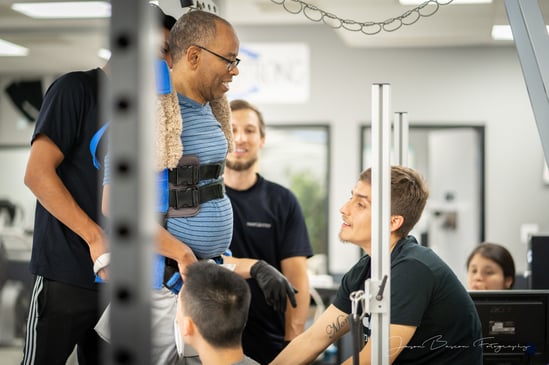For several years, the therapy process of Activity-Based Rehabilitation has been in practice for individuals with brain injury, spinal cord injury, and neurological diseases.  In this process, stimulation is applied to the nervous system through sensory processes to create motor responses. This takes advantage of neuroplasticity, or the nervous system’s ability to adapt using the body’s own power but under the direction of a stimulus.
In this process, stimulation is applied to the nervous system through sensory processes to create motor responses. This takes advantage of neuroplasticity, or the nervous system’s ability to adapt using the body’s own power but under the direction of a stimulus.
Check with your healthcare professional to ensure you are physically ready for this type of activity. Some hidden issues may include blood, contractures, and decreased bone density. It is critical for those with higher-level spinal cord injury or some brain injuries to manage autonomic dysreflexia (AD) responses. There could be other health concerns that are unique to you as well.
Some types of Activity-Based Rehabilitation include:
Range of motion, especially to parts of your body that are movement challenged. Observe as the range of motion to your joints is being done. Think about what is occurring such as toe up, toe down, ankle up, ankle down, ankle rotating, etc. This sends a signal from your brain down your body as the movement sends a signal up.
Weights and Resistance Bands: Utilize equipment to help strengthen your muscles, especially those with movement. Milk bottles with no water, then a little water, and progressively increasing the fluid can serve as weights. Resistance bands are fairly inexpensive and can be increased in tension over time. Do not forget your lungs. Resistance can enhance lung capacity, such as using an incentive spirometer.
Participate in Physical and Occupational Therapy: Once your official rehabilitation has occurred, continue the therapy activities at home. Video your therapy session so you can continue, have a helper present during therapy to learn the techniques, and follow along with prepared handouts.
Gyms: Local gyms often have resources for individuals with differing abilities. Visit a few gyms to see which are right for you.
Standing: Most payor policies allow for a standing frame. This is a form of activity even without movement. Because your body is upright with your weight through your bones, it can be advantageous to use this therapy at home. Many standing frames have reciprocal hand gliders that will move your legs as you stand.
Aquatic Therapy is available in many areas. The buoyancy of the water assists in the movement of weak muscles. Once a movement is identified, strengthen those muscles. You can learn to replicate the movement on land. Look for a heated pool to reduce AD episodes and tone (spasticity).
Functional Electrical Stimulation (FES) is the application of an electrical stimulus through the skin or even implanted. Many individuals know about the FES bikes. There are also smaller simulators that can be applied to one or two muscles. Many new devices are coming to market. If you have been frustrated about getting an FES bike, hold on; more opportunities will soon be available.

 In this process, stimulation is applied to the nervous system through sensory processes to create motor responses. This takes advantage of neuroplasticity, or the nervous system’s ability to adapt using the body’s own power but under the direction of a stimulus.
In this process, stimulation is applied to the nervous system through sensory processes to create motor responses. This takes advantage of neuroplasticity, or the nervous system’s ability to adapt using the body’s own power but under the direction of a stimulus.